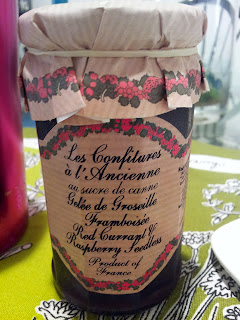One of the major
challenges to French cooking I have found here in America is the fact that
dairy products that are unpasteurized are not allowed. I grew up on unpasteurized milk, cream and
all sorts of “not allowed by the FDA” products, like so many other millions of
people around the world and have never had a problem. Raw dairy builds the immune system up like
crazy, making for strong bones and a general healthy outlook.
From left to
right:
- “Natural by Nature” pasteurized heavy cream. Unlike most cream, this one IS NOT ultra-pasteurized, which means it is boiled only once, and not at very high temperature, which makes for a much more stable and thicker product.
- True whole milk en bouteille de verre, also by “Natural by Nature”, which is sold at Whole Foods Market. It is so thick that you can collect up to 2 tablespoons of cream at the top of the bottle when you open it.
- An excellent option for butters are the French ones from Poitou, a region suited to the rearing of goats. All the dairy from this part of France is extra rich and creamy. This “Sèvre Belle” is slightly salted. Ideal for the baguette and petit noir of the morning.
- Whenever I can, I buy a 1-pound roll of salted and unsalted butter at my local Farmers Market. The one underneath the French butter comes from an Amish farm in Wisconsin from grass-fed cows. You can actually taste the difference.
- For a bit more flavor, especially for ice-cream or a creamy dessert, nothing beats goat’s milk (see the cream leftover inside the bottle). Also available at Whole Foods.
- The Vermont Creamery makes an excellent crème fraîche, one of the staples of French cooking. Their cheeses are also quite imaginative and creamy.
A very good recipe to use two of the products above is a
panna-cotta. I suggest using the goat’s
milk for the vanilla portion and the whole cow’s milk for the chocolate one. It can be done with one or both flavours, and
although it may seem lengthy to prepare, the majority of time required is for
refrigeration. The dessert can be made
up to two days ahead and will keep for another two in the fridge. It is an ideal end for a rather light dinner,
of fish for example, as it tends to be filling.
The measurements are good for 4 servings.
La panna-cotta au chocolat, vainille
e crème de violette:
Ingredients for the vainille et crème de violette panna-cotta:
- 3 Tbsp. cold water
- 2 ¼ tsp. unflavoured gelatin
- 1 cup heavy whipping cream
- 1 cup half and half (combine half cup of cream and half of milk from
“Natural by Nature” brand)
- ½ cup sugar
- 3 Tbsp. crème de violette liqueur
- ¼ Tahitian vanilla bean, scraped
- Pinch of salt
Ingredients
for the chocolate panna-cotta:
- 1 ¾ cups heavy whipping cream
- 1 ¼ tsp. unflavoured gelatin
- 2 Tbsp. sugar
- Pinch of salt
- 2 ounces finely chopped quality dark chocolate, 70% cacao
For
the whipped cream topping:
- ¾ heavy whipping cream
- 2 Tbsp crème de violette liqueur
- A drop or two of violet food colouring
- Small pieces of chocolate for decorating
Preparation for the
vainille et crème de violette panna-cotta:
Pour the cold water into a small bowl and sprinkle with the gelatin.
In a medium saucepan, heat the
cream, half and half, sugar, lavender and salt over medium heat until the sugar
has completely dissolved and the mixture comes to a boil, about 5 minutes.
Remove the saucepan from the
heat and pour the mixture through a fine strainer and into a measuring cup with
a spout. Stir in the crème de violette
and the vanilla seeds, followed by the gelatin mixture, stirring until the
gelatin has completely dissolved.
Divide among 4 individual serving glasses and bring to room temperature, then place on a flat surface in the fridge and refrigerate overnight.
Preparation for the chocolate panna-cotta:
Once the vanilla layer has been set, it’s time to make the chocolate
one.
Pour ¼ cup of the whipping
cream into a small heatproof bowl and sprinkle the gelatin over it. Let sit for 10 minutes. Place the bowl into a larger one with hot
water and stir mixture until the gelatin has completely dissolved.
In a medium saucepan over
medium heat, bring the remaining cream, sugar and salt just to a boil and
remove promptly from the heat. Whisk the
chocolate until completely incorporated and smooth.
Add the gelatin mixture until
well combined, pour it through a fine strainer and into a measuring cup with a
spout. Let sit until it reaches room temperature,
stirring occasionally.
Divide among the chilled vanilla-crème de violette panna-cotta layered glasses, cover with plastic wrap and let chill in the refrigerator overnight.
To prepare the whipped cream topping:






























